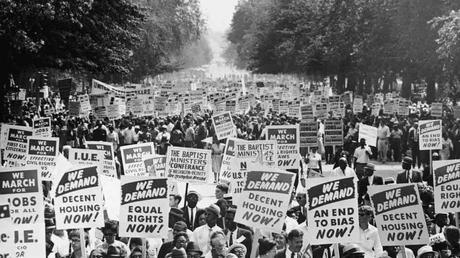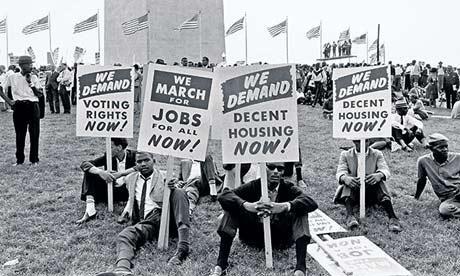 By Alan Bean
By Alan Bean
Casey Sigal is an unsentimental Englishman who worked the civil rights beat in the early 1960s. This piece in The Guardian touches on themes often ignored in mainstream reporting of this week’s commemoration of the March on Washington.
The march, Sigal reminds us, unfolded against a backdrop of fear bordering on dread. Prisons had been emptied to make room for the scores of people sure to be arrested. This is the way official Washington still looked at Negroes in the summer of 1963.
Moreover, the movement itself was sadly divided over tactics. If Martin Luther King Jr. is the man most of us associate with the March on Washington it was probably because of his unique ability to maintain dialog with the old civil rights establishment, the young firebrands associated with SNCC, and the incendiary leadership of Malcolm X. All sides grudgingly agreed to let King take center stage because they knew he understood where they were coming from even if he couldn’t always agree with their conclusions.
King was a feared man in 1963. He came preaching peace and forgiveness, but John and Bobby Kennedy knew they couldn’t embrace King’s message without kissing the Dixiecrat South goodbye. John Kennedy died a few weeks later because his heart, if not his head, was with the civil rights movement and everyone in the South knew it. King was willing to whittle down white fear to a manageable size, but he made no attempt to placate it altogether. White racism was, and remains, an irrational, some would say demonic reality that must be rejected without reservation.
It is the question that introduces and concludes this piece that really intrigues me: what would MLK make of president Barack Obama? Sigal doesn’t think the civil rights giant would be too impressed. What do you think?
Remembering my time at the 1963 March on Washington
As we celebrate the 50th anniversary, we must ask: what would the Rev Martin Luther King think of Obama’s presidency?
By Casey Sigal
Saturday 24 August 2013 07.00 EDT

In 1963, a teenage woman civil rights worker in Albany, Georgia, said, “If you’re not prepared to die here then you’re not facing reality”.
Any of us who participated in the 1963 March on Washington for Jobs and Freedom will celebrate its 50th anniversary with a combination of sweet nostalgia and mixed feelings about its “legacy”. For me, and so many others, the event itself was redemptive and personally transforming. It had been a terrible year for African Americans and civil rights activists, a blood-drenched inventory of violence that included the jail beating of Fannie Lou Hamer and assassination of Medgar Evers. So on that Wednesday, 28 August, when 300,000 Americans from right across what I call the “decency spectrum” descended on an almost deserted Washington, it was as if a Norman Rockwell painting had come alive.
They – we – had come by bus, plane, train, car and hitch-hiker’s thumb to demonstrate to ourselves and a watching world that there was a better, more righteous America than the Birmingham of Bull Connor who had set the dogs and fire hoses on black children. Our emotions – and amazing self-discipline – ran high. White Washington right on up to the White House was scared silly of all us black and white folks mixing together. Apocalypse was confidently predicted. The nation’s capitol had “its worst case of invasion jitters since the First Battle of Bull Run“, as a contemporary newspaper put it.
Wandering on the crowd’s fringes, I talked to city cops and National Guardsmen – the Pentagon had mobilized almost 20,000 troops for the feared riot – who were white-faced scared to the point of hysteria. Businesses had shut down; liquor was banned; jails were emptied to make room for the anticipated mass arrests; emergency room doctors were called in on their days off.
But, against the doomsayers, an almost supernatural peace and good will reigned. Strangers became lifelong friends. A lot of us were astonished at how beautiful and strong we felt. On that hot, sunny day a genuine rainbow coalition of Quakers, Catholics, atheists, black and white church and social justice groups, labor unions, socialists and God-fearers poured into Washington because we felt that it was terribly important to be there.
Everyone who marched has their own special memory. Although the event comes down to us mainly as the Rev Martin Luther King‘s “I have a dream” speech to the huge throng standing in the sweltering heat or sprawled cooling their toes in the Mall’s reflecting pool, I remember it as one big picnic with everyone in their Sunday best and on their best manners firmly clasping hands in King’s “beloved community”. The anger that had brought us together was for, at least this day, something else.
But it wasn’t all kumbaya. More than half the American public viewed King as a dangerous troublemaker, a pariah. In the White House, a bet-hedging President John Kennedy and his attorney general brother Bobby, rightly fearing the loss of Dixiecrat votes in the ’64 presidential election, pleaded with King and the organizers to delay, postpone or tone down the event. The FBI’s racist chief J Edgar Hoover did everything in his power to smear the black leaders as communist subversives. Even the main African-American organizers – notably the gay socialist Bayard Rustin, A Philip Randolph of the Brotherhood of Sleeping Car Portersand King himself – dreaded the possibility that such a concentration of angry blacks and civil rights workers might end in a riot.
Privately, behind the scenes, there was a real split between the older, traditional civil rights leaders (NAACP, CORE, Urban League, Southern Christian Leadership Conference) bent on de-radicalizing the movement so as to give the Kennedys elbow room to pass Civil Rights and Voting Rights bills – against the (very) young foot soldiers of SNCC, the Student NonViolent Coordinating Committee, whose willingness to suffer fractured skulls and hair-breadth escapes from lynchings had provided much of the movement’s moral and physical energy.
It had been a slow time coming. As long ago as the 1940s, Randolph had threatened President Roosevelt with a similar march if the government did not enact an anti-discrimination bill. Then the second world war intervened, which gave us the all-black Tuskegee Airmen and also created a new, less deferential type of black soldier demanding to be treated at least as civilly as white military base commanders dealt with their Nazi prisoners of war.
I came to the ’63 march by a strange route. London-based, I was returning to the United States after a seven-year absence and had the good luck to follow in the footsteps of the Guardian’s US correspondentWJ (Bill) Weatherby whose sympathy for the black liberation struggle had left behind strongly positive vibes for me to take advantage of. In Detroit, a racially hot city that had seen bloody riots and soon would again, I worked (and reported) alongside Malcolm X’s brother Wilfred X. This gave me an “in”. From then on I was passed hand to hand along a “black pipeline” of civil rights activists until I passed through Selma, Alabama to Albany, Georgia and on to Rustin and King’s march.
Malcolm X and King played a strange game, each working opposite sides of the same street. Malcolm’s voice, via radio and pirated tapes, hurled a defiant challenge to King’s Gandhian nonviolence. “By any means necessary!” his voice crackled. “Whoever heard of a revolution where they lock arms and singing We Shall Overcome? You don’t do that in a revolution. You don’t do any singing; you’re too busy swinging!” And the Detroit masses of blacks roared their approval. Meanwhile, King plowed his own ground preaching love and brotherhood. In my opinion, each shrewdly knew what the other was up to: Malcolm raising the stakes with his angry rhetoric made King, who most Americans really didn’t like or approve of, at least mildly acceptable.
On the podium at the Lincoln Memorial, a furious debate went on right up to the last moment. SNCC’s John Lewis, representing bold young activists, wanted to make a fiery speech warning Kennedy that “We will march through the South, through the heart of Dixie, the way Sherman did. We shall pursue our own scorched earth policy and burn Jim Crow to the ground…” His elders shut him up. They also banned the “inflammatory” writer James Baldwin from appearing.
Although black women were the backbone of the voting rights movement, none of the official speeches were by women.
Nonetheless, sheer love flowed from the march – but also hate. There was an immediate gruesome backlash. The next month, as if in retaliation, four KKK members dynamited Birmingham’s 16th Street Baptist church killing four little girls on their way to hear a sermon “The Love That Forgives”. All over the South racist cops and white supremacist groups stepped up their beatings and shootings. And, of course, only weeks later Kennedy was murdered in a racially inflamed Dallas.
John Lewis, now a Georgia congressman, is the only survivor of the March’s original organizers. He has lived long enough to see an African American in the White House and a black attorney general – no small victories. Lewis has also lived long enough to see that even a black president can be tone deaf to the spirit of King’s life. If King, an apostle of non-violence and advocate for the poorest of the poor, were alive today, what would he make of President Obama’s careless-with-life drone assassinations, his bullying of journalists and whistleblowers, his assent to slashing Social Security via his Scrooge-like “deficit commission”? Without irony, the current 50th birthday organizers have invited Obama to speak from the very same podium where King made history.
